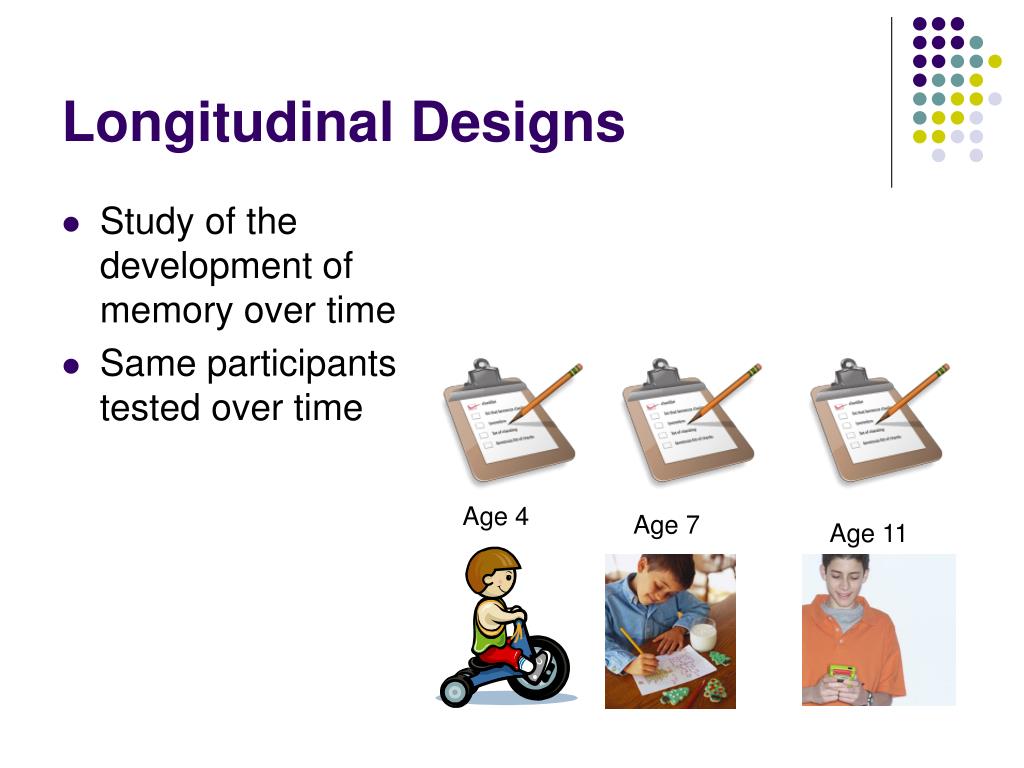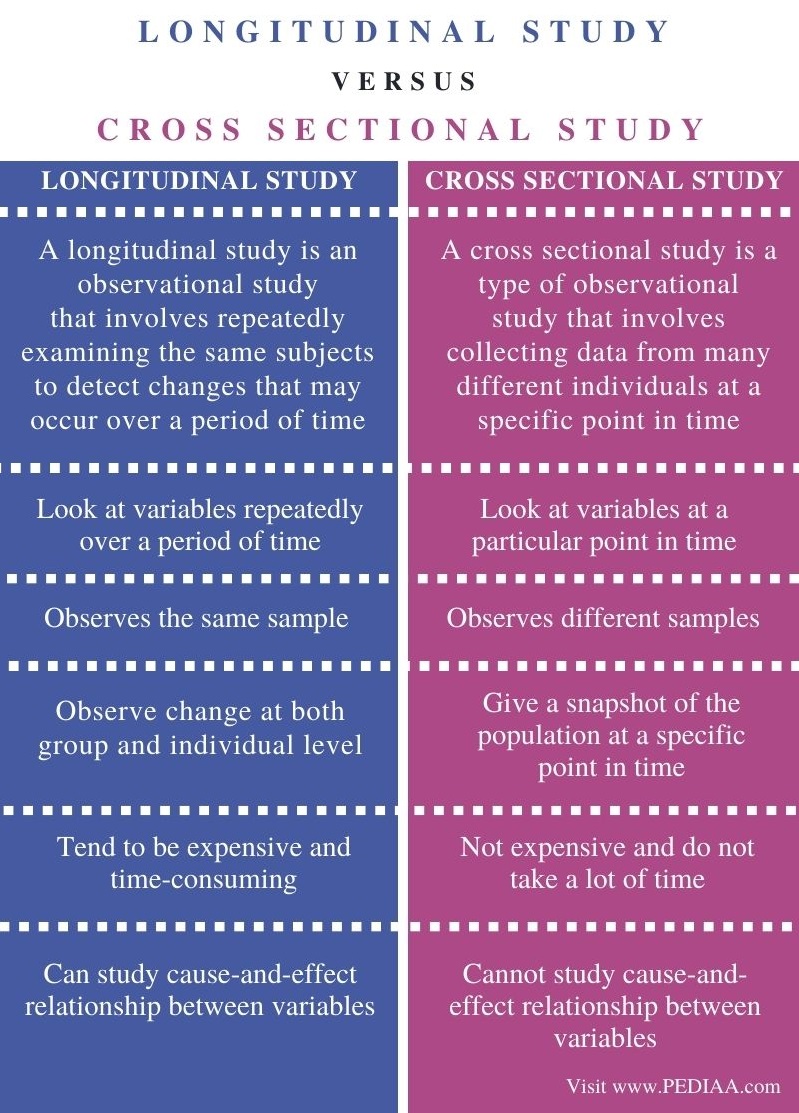Table Of Content

Additionally, in a longitudinal study, a survey creator does not interfere with survey participants. Instead, the survey creator distributes questionnaires over time to observe changes in participants, behaviors, or attitudes. The Framingham study is widely recognised as the quintessential longitudinal study in the history of medical research. An original cohort of 5,209 subjects from Framingham, Massachusetts between the ages of 30 and 62 years of age was recruited and followed up for 20 years. It is largely quoted as a successful longitudinal study owing to the fact that a large proportion of the exposures chosen for analysis were indeed found to correlate closely with the development of cardiovascular disease. In a panel study, the researcher uses data collection methods like surveys to gather information from a fixed number of variables at regular but distant intervals, often spinning into a few years.
Retrospective Study
For instance, in the Genetic Studies of Genius described above, the life prospects of all the subjects would have been impacted by events such as the Great Depression and the Second World War. At the same time, a lot of misinformation prevailed about the perceived harmful effects of using oral contraceptives. The Baltimore Longitudinal Study of Aging (BLSA) was initiated in 1958 to study the effects of aging, making it the longest-running study on human aging in America. Later the study shifted to Vanderbilt University and was expanded to include children who scored exceptionally high in the verbal section of the SATs as well.
Examples of Longitudinal Studies
Longitudinal study designs are implemented when one or more responses are measured repeatedly on the same individual or experimental unit. These designs often seek to characterize time trajectories for cohorts and individuals within cohorts. Longitudinal designs may be either randomized where individuals are randomly assigned into different groups or observational where individuals from different well-defined groups are observed over time. I conclude with discussion of recent topics of interest in the modeling of longitudinal data including models for intensive longitudinal data, latent class models, and joint modeling of survival and repeated measures data.
Title:Sample Design Engineering: An Empirical Study of What Makes Good Downstream Fine-Tuning Samples for LLMs
Governmental and research institutes often carry out longitudinal studies and make the data available to the public. So you can pick up their previously researched data and use them for your own study. For example, let’s say you are researching social interactions among wild cats. You go ahead to recruit a set of newly-born lion cubs and study how they relate with each other as they grow.
This increases the speed and cost-efficiency of longitudinal data collection and enables the examination of age/cohort effects. Appropriate multilevel statistical models are required to analyze the resulting complex data structure. Like with every research method, longitudinal studies have their advantages and disadvantages. While trying to understand what is a longitudinal study, it is important to get the particular ways in which they’re useful, and situations in which they’re not.
The Minnesota twin study was a longitudinal study that set out to find an answer to this question by studying a group of twins from 1979 to 1990 under the supervision of Thomas J Bouchard. Conducting a longitudinal study with surveys is straightforward and applicable to almost any discipline. Additional data points can be collected to study unexpected findings, allowing changes to be made to the survey based on the approach that is detected. When using this method, a longitudinal survey can pay off with actionable insights when you have the time to engage in a long-term research project.

In such a design, one group (the experimental group) would receive treatment or intervention, while the other group (the control group) would not. Longitudinal studies tend to require more time and resources, but they can be used to detect cause-and-effect relationships and establish patterns among subjects. Latent state-trait models decompose the covariance between longitudinal measurements into time-invariant trait factors, time-specific state residuals, and error variance.
Despite the initial intent of random selection, they needed the addition of over 800 volunteers to reach the pre-defined target of 5,000 subjects thus reducing the randomisation. They also found that their cohort of patients was uncharacteristically healthy. Numerous predisposing factors were postulated to align together to produce cardiovascular disease, with increasing age being considered a central determinant. These formed the basis for the hypothesis that underpinned this longitudinal study. Inaccuracies in the analysis of longitudinal research are rampant, and most commonly arise when repeated hypothesis testing is applied to the data, as it would for cross-sectional studies. This leads to an underutilisation of available data, an underestimation of variability, and an increased likelihood of type II statistical error (false negative) (8).
Any divergence suggests inflated scores due to retesting rather than true change. Cohort effects occur when different cohorts show differing trajectories over time. Longitudinal studies will sometimes rely on surveys and questionnaires, which could result in inaccurate reporting as there is no way to verify the information presented. If the final group no longer reflects the original representative sample, attrition can threaten the validity of the experiment. Validity refers to whether or not a test or experiment accurately measures what it claims to measure.
One key difference is that longitudinal studies follow the same sample of people over an extended period of time, while cross-sectional studies look at the characteristics of different populations at a given moment in time. Latent growth curve models allow researchers to model intraindividual change over time. For example, one could estimate parameters related to individuals’ baseline levels on some measure, linear or nonlinear trajectory of change over time, and variability around those growth parameters.
Longitudinal saliva omics responses to immune perturbation: a case study Scientific Reports - Nature.com
Longitudinal saliva omics responses to immune perturbation: a case study Scientific Reports.
Posted: Tue, 12 Jan 2021 08:00:00 GMT [source]
Many governments or research centres carry out longitudinal studies and make the data freely available to the general public. For example, anyone can access data from the 1970 British Cohort Study, which has followed the lives of 17,000 Brits since their births in a single week in 1970, through the UK Data Service website. However, not all longitudinal studies have a control group, especially observational ones and not testing a specific intervention. They collect numerical data from the same subjects to track changes and identify trends or patterns.
Longitudinal studies repeatedly observe the same sample population, while cross-sectional studies are conducted with different research samples. Longitudinal studies allow researchers to follow their subjects in real time. This means you can better establish the real sequence of events, allowing you insight into cause-and-effect relationships.
Assumptions about missing data mechanisms (e.g., missing at random) shape the analytic approaches taken. As a result, the study is now believed to be one of the largest and the most expensive observational health studies in history. Over time, the study expanded to include not just oral contraceptives but also smoking, exercise, and obesity within the ambit of its research. The nurses’ health study aimed to study the long-term effects of the use of these pills by researching a sample composed of female nurses. The Nurses’ Health Study began in 1976 to study the effects of oral contraceptives on women’s health.
It was discovered that intellectually gifted children had the same social skills and the same level of physical development as other children. The objective of the study at its commencement in 1921 was to study the life trajectories of exceptionally gifted children, as measured by standardized intelligence tests. The Terman Life-Cycle Study, also called the Genetic Studies of Genius, is one of the longest studies ever conducted in the field of psychology. In short, the results gleaned from the study (so far) strongly indicate that the quality of our relationships is one of the biggest factors in determining our quality of life.
If you want to create a longitudinal survey, don’t forget to first plan out your survey. A retrospective study, like we just talked about, can also be a great solution to your problems. There is no better example to understand what longitudinal research is than the 45 and Up study being conducted in Australia. It aims to understand healthy aging and has 250,000 participants who are aged 45 or older.
Also unlike the Up Series, the MCS has a much larger sample size of 18,818 subjects representing a much wider ethnic and socio-economic cross-section of British society. It attempted to study food consumption, dietary patterns, and household expenditures on food by British citizens. 14 children were selected from different socio-economic backgrounds for the first study in 1963 in which all were 7 years old. They are constantly shifting, and one survey taken years ago is not going to give you an accurate picture of the shifts in trends. Knowing what information a study should gather is the first step in determining how to conduct the rest of the study.










